Delhi - Kathmandu - Chitwan - Kathmandu - Varanasi - Khajuraho - Agra - Jaipur - Jodhpur - Udaipur
Day 01 : Arrive Delhi
Arrive Delhi. Meeting and assistance on arrival then transfer to hotel.
Day 02 : In Delhi
Breakfast at the hotel. Later full day sightseeing of New & Old Delhi. In New Delhi visit the 12th century Qutab Minar, gracefully hand-carved for its entire height of 234ft. and the iron pillar, which has withstood the ravages of time, the mausoleum of emperor Humayun, Drive past India Gate (memorial to viceroy’s residence) and the Parliament House, continue to Old Delhi, drive past Red Fort - a marvel in red sandstone, the Raj Ghat - memorial to Mahatma Gandhi, Overnight at hotel.
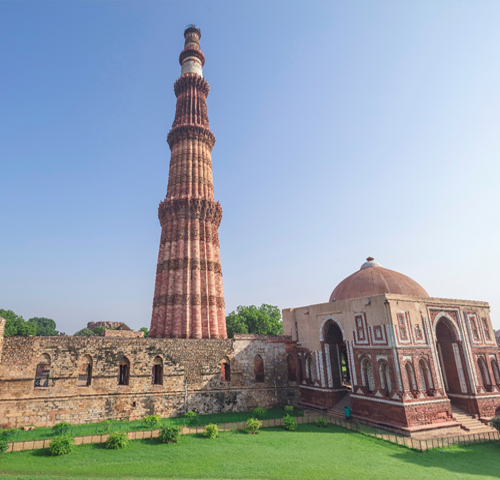
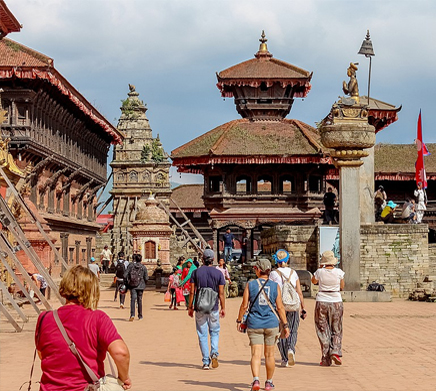

Day 03 : Fly Delhi - Kathmandu
Breakfast at the hotel. Later transfer to airport to connect flight for Kathmandu. On arrival transfer to airport. Rest of the day at leisure. Overnight at hotel.
Day 04 : Kathmandu
Breakfast at the hotel. Morning half city sightseeing tour visiting the Durbar Square, Nearby is Narayanhity Palace, the home of Nepal's monarch. Though this place is out of bound for the tourists , one can very well appreciate the beauty from outside. Hanuman Dhoka, the ancient royal residential quarter, Mahadev and Parvati Temple, Machhender Bahl-holy place for the Buddhists and Hindus, Temple House of Kumari, the vestalvirgin or the living goddess. Walk around the local bazaars.
Afternoon excursion to Patan and Swayambhunath. Patan is one of the major cities of Nepal. Patan is considered to be the oldest and most beautiful among the three royal cities ( Kathmandu, Patan, Bhaktapur ) in the Kathmandu Valley. It is best known for its finest tradition of arts and crafts and its rich cultural heritage. Also visit Swayambhunath, a 2500-year old site where, it is believed, the Radiant Lotus of the valley-mythology, settled when the water was drained by Manjushri, the god of Wisdom. (Non Hindus are not allowed inside Swayambhunath temple). Overnight at hotel.
Day 05 : Kathmandu
Breakfast at the hotel. Morning visit Pashupatinath, Bodnath, Bhadgaon and Nagarkot.
Pashupatinath is situated on the banks of river Baghmati. Here Shiva is worshipped in the form of lingam. (Only Hindus are allowed inside). In the month of February an annual pilgrimage on the occasion of Shivaratri is organized here every year. Bodnath is an important Buddhist pilgrimage centre. Visit the temple of Bodhnath, the collosal Stupa, one of the largest in the world. Also visit Bhadgaon - another Newar city founded in the 9th century. Visit the ancient gateway, Durbar Square the Royal Residential quarter of Bhupendra Malla, the famous five-storeyed temple of Nytapole in pagoda-style and other temples.
Afternoon visit Nagarkot situated 32 kms east of Kathmandu at an altitude of 2175m above the sea level. Nagarkot is a famous place to see the mountain ranges and sunrise and has been the favorite summer resort of Kings and Maharajas for its cool climate and the scenic beauty around. If weather is good, one can see great views of Himalayas including Annapurna, Langtang, Dorje Lakpa and Gauri Shanker, Ganesh Himala and Everest can be seen from here. Overnight at hotel.

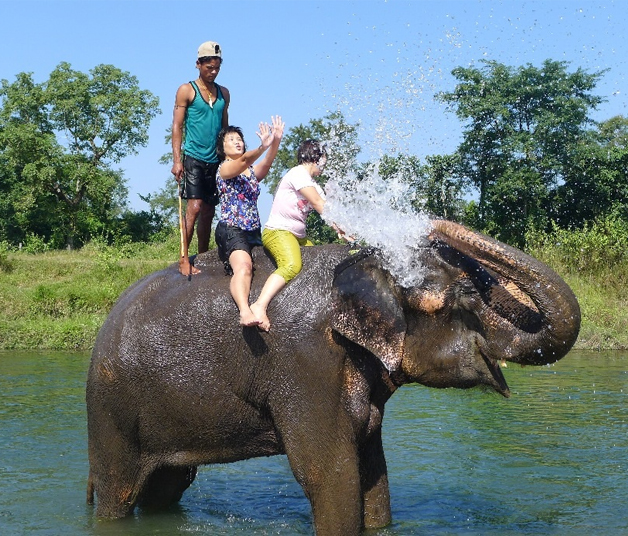
Day 06 : Kathmandu-Chitwan
Breakfast at the hotel. Later transfer to airport to board flight for Chitwan. On arrival transfer to hotel. Chitwan, at the foot of the Himalayas, is one of the few undisturbed areas of the Terai region which formerly extended over the foothills of India and Nepal, with its very rich flora and fauna. Rest of the day at leisure. Overnight at the hotel.
Day 07 : Chitwan
Breakfast at the hotel.Morning visit the Royal Chitwan National Park (‘Chitwan’ means "in the heart of the jungle’) which covers 932 sq. km. in the flat lowland region of southern Nepal. One of the last populations of single-horned Asiatic rhinoceros lives in the park, which is also among the last refuges for the Bengal tiger. It is one of the most important sub-tropical parks on the Indian subcontinent with populations of the endangered Royal Bengal tiger, Greater One-horned rhinoceros, Gangetic dolphin , Wild Asian elephant, Gaur, Golden Monitor lizard, Gharial crocodile and many more Overnight at hotel.
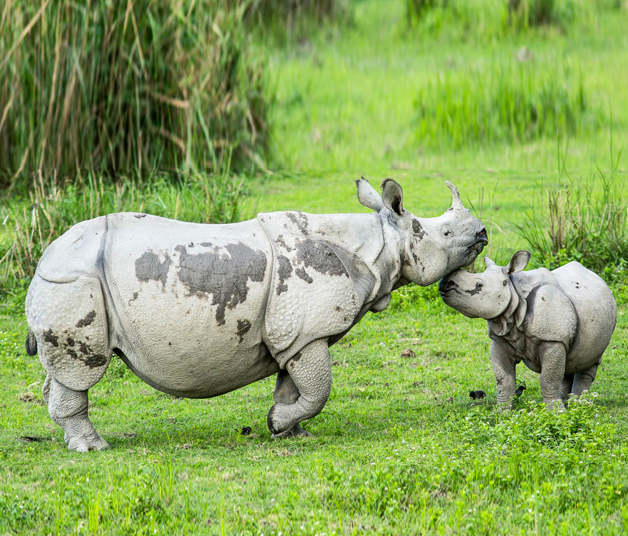
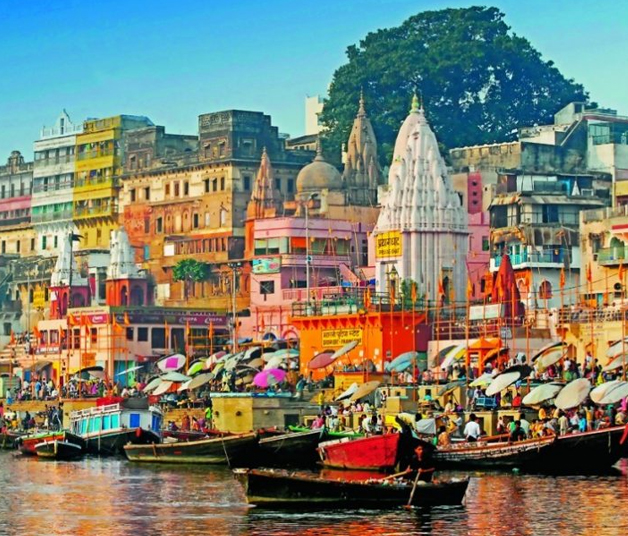
Day 08 : Fly Chitwan-Kathmandu
Breakfast at the hotel. Later transfer to airport to board flight for Kathmandu. On arrival transfer to hotel. Rest of the day at leisure. Overnight at hotel.
Day 09 : Fly Kathmandu-Varanasi
Breakfast at the hotel. Later transfer to airport to connect flight for Varanasi. On arrival transfer to hotel. Varanasi (also known as Benares, Kashi and Kasi) is a Hindu holy city on the banks of the Ganges River in the north Indian state of Uttar Pradesh. Varanasi is considered the most sacred place for all Hindus, irrespective of denomination. Hindus have long believed that bathing in the Ganges or dying in the holy city of Varanasi circumvents reincarnation and hence provides a permanent place in the Swarg (Heaven). Varanasi is the site of the holy shrine of Lord Kasi Viswanatha (a form of Lord Shiva) and is one of the revered 12 yotirlingas of the Lord.
Time permitting experience Varanasi intimately when you go on a leisurely rickshaw, ride through the narrow streets and alleys of Varanasi. In the evening the Ghats and temples are lit with oil-lamp lights or candles. Participate in an Arti Ceremony (collective prayer) and watch the floating Diyas (lamps) on the river Ganges. Overnight at hotel.
Day 10 : Varanasi-Khajuraho
Early morning Boat cruise on river Ganges. At dawn, the Ghats are abuzz with activity of the devotees performing their ablutions in the river or offering prayers to the rising sun and performing other religious rituals. Every morning Varanasi attracts thousands of bathers, local as well as pilgrims, who come here to purify themselves by washing away their sins in the holy (but rather dirty) waters of river Ganga, as it is affectionately known here. Later, visit the Vishwanath temple, also called the golden temple because of the gold-plating on its roof. Return back to hotel for breakfast at the hotel.
After breakfast check-out and leave for Sarnath, 10-Kms away from Varanasi is the fabled place, which bears testimony to its great past where Lord Buddha delivered his first sermon to his disciples, expounding the principles of Buddhism. Visit the art collection at the Archaeological Museum. The main attraction is the superb Capital from Ashokan Pillar - the Ashokan symbol of four back-to-back Lions which has been adopted as the state symbol Independent India. Also visit the Mahabodhi'Buddha temple. Later transfer to airport to connect flight for Khajuraho. On arrival transfer to hotel.
Afternoon city tour of Eastern Group of Temples. The Eastern Group of temples include the Ghantai Temple, Vamana Temple dedicated to the "Vamana" or dwarf incarnation of Lord Vishnu and the Javari Temple. There are also three Jain Temples with beautiful carvings and non-erotic sculptures. Although these are Jain Temples, they also contain numerous Vaishnav deities. The Khajuraho group of monuments has been listed as a UNESCO World Heritage Site. Overnight at hotel.

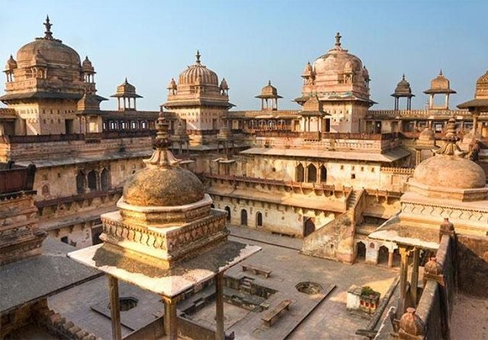
Day 11 : Khajuraho-Jhansi-Agra
Breakfast at the hotel. Later drive to Jhansi railway station (198 Kms / 5 Hrs) Orcha visiting Orcha Enroute.Orcha, one of the ancient city situated on the bank of Betwa. Its grandeur has been captured in stone, frozen in time, a rich legacy of the ages. For this medieval city, the hand of time has rested and the palaces and the temples built by its Bundela rulers in the 16th 17th century retain much of their pristine perfection. Jehangir Mahal, a tiered palace crowned by graceful Chhatries commands a spectacular view of soaring temple spires and cenotaphs.
Later transfer to Jhansi railway station (16 Kms) to board Shatabdi Express for Agra (1755-2005 Hsr). On arrival transfer to hotel.
Day 12 : Agra
Breakfast at the hotel. After breakfast check-out and proceed to world famous Taj Mahal built by Shah Jahan in 1560 in memory of his queen Mumtaz Mahal to enshrine her mortal remains. This architectural marvel is a perfectly proportioned masterpiece fashioned from white marble that stands testimony to the skill of 20,000 craftsmen brought together from Persia, Turkey, France and Italy and who took 17 years to complete this 'Love Poem in Marble' (Friday Closed).
Also visit the Agra fort, built alongside the Yamuna river stretching almost 2.5 km. The fort’s colossal double walls rise 20 m in height and measure 2.5 km in circumference. The fort is surrounded by a moat. The magnificent towers, bastions and ramparts and majestic gateways symbolized the confidence and power of the third Mughal emperor. The fort contains splendid palaces both in red sandstone and white marble built by two generations of prolific builders, Afternoon at leisure Overnight stay at hotel.

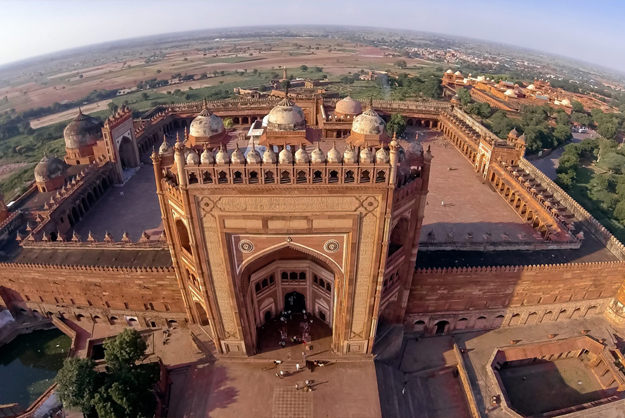
Day 13 : Drive Agra-Jaipur
Breakfast at the hotel.After breakfast leave for Jaipur (221 Kms/5 Hrs) visiting Fatehpur Sikri (46 Kms from Agra) enroute.Fatehpur Sikri, Akbar’s City of Victory, lies on a hill top almost 40 kms from Agra. It has two different complexes- the royal enclosure of the palaces with the harem and official buildings; and the dargah of the Sufi saint, Salim Chisti with a mosque and gateway. The buildings at Fatehpur Sikri belong to a composite style of architecture with the predominating Islamic style cleverly blended with local Rajasthani and Gujarati styles, a melting pot of cultures. Later drive to Jaipur. On arrival check-in at hotel. Overnight at hotel.
Day 15 : Jaipur
Breakfast at the hotel. Post breakfast proceed to Amber Fort visiting Hawa Mahal - the Palace of Winds, a la ndmark of Jaipur, a five-storied wonder with a spectacular pyramidal facade and overhanging windows with latticed screens, domes and spires. Visit Amber Fort, a classic, romantic Rajasthani Fort Palace. The rugged, time-ravaged walls of the Fort may not look beautiful from the outside, but the interior is a virtual paradise. Miniatures painted on the walls depict hunting and war scenes, apart from festivals.
Afternoon visit the Maharaja's City Palace, the former Royal residence, part of it converted into a museum built in the style of a fortified campus. One of the major attractions in the museum is the portion known as Armoury Museum housing an impressive array of weaponry-pistols, blunderbusses, flintlocks, swords, rifles and daggers. Later visit the Jantar Mantar, which is the largest stone and marble crafted observatory in the world. built in the 18th century with a collection of giant masonry astronomical instruments that continues to provide accurate information even today. Evening at leisure. Overnight at hotel.
Day 16 : Fly Jaipur- Jodhpur
Breakfast at the hotel. Later transfer to airport to connect flight for Jodhpur. On arrival transfer to hotel. Rest of the day at leisure. Overnight at hotel.
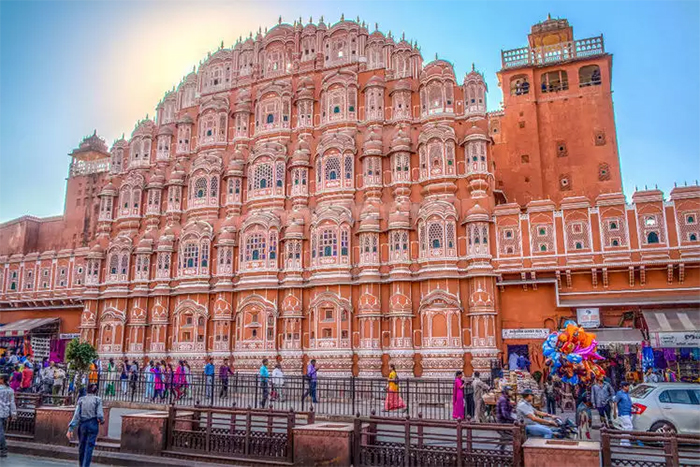

Day 17 : Jodhpur
Breakfast at hotel. Afternoon visit the impressive 5 km long Mehrangarh Fort on a 37 m low sandstone hill built by Rao Jodha in 1459. Within the fort are some magnificent palaces with meticulously carved panels, latticed windows or "Jarokhas" with evocative names. From the top of the fort one can get a bird’s eye view of the old city. Proceed to the Jaswant Thada, an imposing marble cenotaph built in 1899 for Maharajah Jaswant Singh II, and smaller memorials to other Maharajahs of Jodhpur. Afternoon at leisure. Overnight at the hotel.
Day 18 : Jodhpur- Udaipur By Surface (290 Kms / 6-7 Hrs)
Breakfast at the hotel.After breakfast drive to Udaipur En-route visit Ranakpur, the wonderful 3 temples of the Jain sect dating back to the 14th/15th century. The unforgettable main Temple dedicated to Adinatha the first Tirthankar (1439) built in marble took 65 years to complete. It is one of the five holy Jain pilgrimage centres, and has one of the best temple complexes. After the visit to Ranakpur temples continue driving to Udaipur. On arrival in Udaipur, check in at the hotel. Overnight at the hotel.
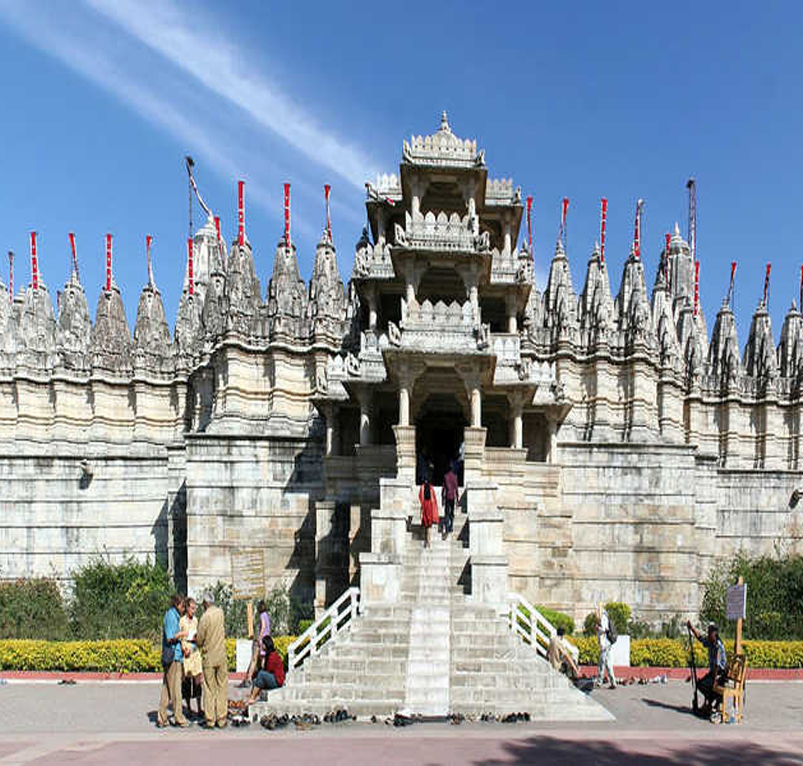
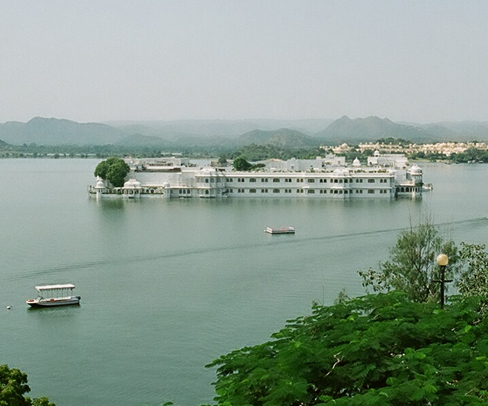
Day 19 : Udaipur
Breakfast at the hotel.After breakfast visit the City Palace built on the bank of the Pichola Lake, by Maharana Udai Singh in 1570. The impressive complex of several palaces is a blend of Rajput and Mughul influences. The Jagdish Temple (1651) built by Maharana Jagat Singh is a fine example of the Nagara style of temple architecture. A brass Garuda stands outside and stone elephants flank the entrance steps Inside is a black stone image of Vishnu as Jagannath, the Lord of the Universe. Sahelion-ki Bari an ornamental pleasure garden specially made for the ladies of the palace in the 18th century. It has beautiful fountains, trees and flowers. Late afternoon enjoy boat ride on Lake Pichola. Overnight at hotel.
Day 20 : Fly Udaipur- Mumbai
Breakfast at the hotel. Later transfer to airport to board flight for Mumbai. On arrival in Mumbai connect flight for onward destination.